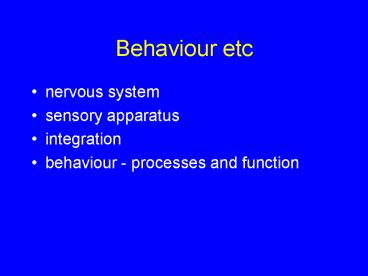Behaviour etc - PowerPoint PPT Presentation
1 / 31
Title: Behaviour etc
1
Behaviour etc
- nervous system
- sensory apparatus
- integration
- behaviour - processes and function
2
Nervous system
- insect nerve cells are complex
- insect nerve cells have highest metabolic rate of
any known tissue - insect nerve cells respond faster than ours
(small size of brain) - insect nerve cells cant send long range pulses
quickly - insect nerve cells dont have redundancy
3
(No Transcript)
4
organisation
- 2 ventral nerve chords segmental ganglia
- CNS primitively ladder
- CNS has tendency to become fused
- brain supra- suboesophageal ganglia
5
(No Transcript)
6
(No Transcript)
7
sense organs
- mainly setae many kinds of sensory setae
- mechanosensory, chemosensory etc
- campaniform - cuticular stress
- placoid - chemoreception
- chordotonal organs - limb position
- equilibrium sensors (e.g. Johnsons organ
8
(No Transcript)
9
vision
- ocelli
- stemmata
- compound eyes
10
- ocelli - late instar hemimetabolous insects,
adult insects fast response, some may detect
images. Used in horizon detection, flight control - stemmata - larvae of holometabolous insects.
Largely light/dark detectors, limited image
formation - compound eyes - larvae of hemimetabolous insects,
adult insects. Used to detect images
11
(No Transcript)
12
(No Transcript)
13
ommatidia organisation
- corneal lens
- crystaline cone - feeds light into rhabdomeres
- rhodopsins oriented in villi of rhabdomeres
- 3 colour (sometimes 4 colour) vision
- UV/blue/green, sometimes red
- detector cells twist, short (UV) cell detects
polarization
14
apposition compound eyes
- commonest form in insects operating in daylight
- each ommatidium provides information from a
narrow solid angle about its axis - axes not oriented radially, some areas densely
sampled by ommatidia arranged almost parallel
(fovea) - complex neural circuitry combines information
from adjacent ommatidia
15
superposition compound eyes
- mainly nocturnal insects ( (modified) in
butterflies) - lens systems of many ommatidia act as little
telescopes and generate an erect image on the
retina (made up of the packed detector elements
of many ommatidia) - eyes have a clear space and produce eye-shine
- resolution not quite as good as apposition eye,
light collection 10-100x better
16
muscid eyes
- only found in muscoid flies (houseflies,
blowflies, tachinids etc) - apposition eyes BUT detector elements dont twist
AND detector elements from adjacent ommatidia
that are looking in the same direction are
hooked up through a complex nerve mesh - good light detection capability, good resolution
- associated with need to collect photons to
compensate for effects of rapid turning flight
17
vision
- extensive neural processing in optic lobe,feature
detection circuits similar to ours - motion detection
- image detection
- speed of processing (flies have flicker-fusion
thresholds gt 5 x ours)
18
- insect vision is a field of very active research
and ANU is a world leader - we now know insects are MUCH more capable than
was thought the case even 10 years ago - emulation of insect vision is proving a fertile
field in robotic vision - other insect senses are likely to prove equally
impressive
19
behaviour
- navigation
- behaviour/ecology
- development
- maintenance
- mating systems
20
navigation
- use of vision
- landmarks wasp, bee first flights
- use of sun compass
- use of polarization pattern if sun not visible
- time clock to compensate for suns apparent
movement - other senses - chemical, remembering steps
21
use of landmarks
- originally investigated in sphecid wasps
- Philanthus work - Tinbergen
- use of landmarks
- availability
- kinds preferred
- hierarchy of landmarks used at different scales
- hierarchy of backups remembered
22
(No Transcript)
23
sun compass
- use position of sun in sky to navigate
- time clock to compensate for suns apparent
movement (even overnight!) - enables flight over long ranges or uniform
habitat (ranges of kms) - use of polarization pattern in small patches of
clear sky if sun not visible
24
other senses
- chemical gradients
- magnetic sense
- remembering steps
- REAL navigation almost always involves a
hierarchy of different senses, with backups
25
behaviour and ecology
- behaviour is a key process underlying ecology
- example we will take dragonfly life
history(will bounce around a range of species)
26
larval stages
- Diphlebia is the concrete example
- females lay eggs in rotten wood floating in pools
- micro-habitat of earliest larval stages unknown
- later stages occur under rocks in riffles
- emerge at night to hunt prey on rocks
27
adult maintenance
- thermoregulation
- conformers
- heliothermy
- myothermy
- feeding
- prey detection
- interception
28
mating systems
- e.g. dragonflies (very well studied)
- rendezvous, operational sex ratio
- male behaviour
- sperm competition
- female responses to limit interference
- mating in dragonflies requires female action
males can hold on to encourage - but may lose
opportunities
29
sperm competition
- Insects preadapted for strong sperm competition -
sperm stored, only a few used per egg, eggs
fertilized at laying - displacement or extraction of previous sperm
- mate guarding to prevent take over by another
male (with consequent loss of stored sperm)
30
exercise
- examination of dragonfly mating systems
31
References
- Physiology Imms Outlines of entomology as
revised CSIRO Insects of Australia - Behaviour navigation, mating systems/sperm
competitionAlcock Animal behavior an
evolutionary approach - dragonflies Corbet Dragonflies behavior and
ecology of Odonata































